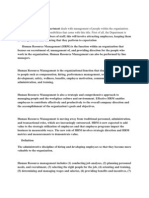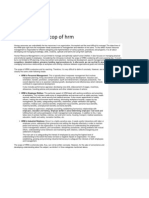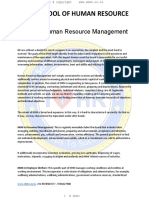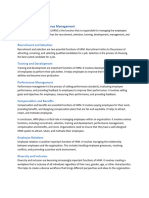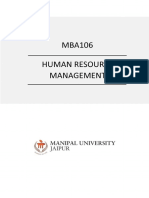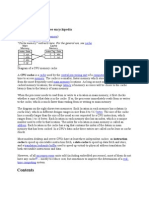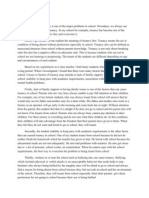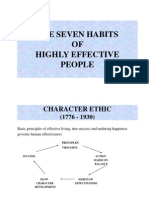HPM N Scope
HPM N Scope
Uploaded by
devank1505Copyright:
Available Formats
HPM N Scope
HPM N Scope
Uploaded by
devank1505Original Title
Copyright
Available Formats
Share this document
Did you find this document useful?
Is this content inappropriate?
Copyright:
Available Formats
HPM N Scope
HPM N Scope
Uploaded by
devank1505Copyright:
Available Formats
Human Resource Management (HRM) is the function within an organization that focu ses on recruitment of, management of,
and providing direction for the people who work in the organization. HRM can also be performed by line managers. HRM is the organizational function that deals with issues related to people such as compensation, hiring, performance management, organization development, safe ty, wellness, benefits, employee motivation, communication, administration, and training. HRM is also a strategic and comprehensive approach to managing people and the wo rkplace culture and environment. Effective HRM enables employees to contribute e ffectively and productively to the overall company direction and the accomplishm ent of the organization's goals and objectives. HRM is moving away from traditional personnel, administration, and transactional roles, which are increasingly outsourced. HRM is now expected to add value to t he strategic utilization of employees and that employee programs impact the busi ness in measurable ways. The new role of HRM involves strategic direction and HR M metrics and measurements to demonstrate value.
The scope of HRM is extensive and far-reaching. Therefore, it is very difficult to define it concisely. However, we may classify the same under following heads: HRM in Personnel Management: This is typically direct manpower management th at involves manpower planning, hiring (recruitment and selection), training and development, induction and orientation, transfer, promotion, compensation, layof f and retrenchment, employee productivity. The overall objective here is to asce rtain individual growth, development and effectiveness which indirectly contribu te to organizational development. It also includes performance appraisal, developing new skills, disbursement of wages, incentives, allowances, traveling policies and procedures and other re lated courses of actions. HRM in Employee Welfare: This particular aspect of HRM deals with working co nditions and amenities at workplace. This includes a wide array of responsibilit ies and services such as safety services, health services, welfare funds, social security and medical services. It also covers appointment of safety officers, m aking the environment worth working, eliminating workplace hazards, support by t op management, job safety, safeguarding machinery, cleanliness, proper ventilati on and lighting, sanitation, medical care, sickness benefits, employment injury benefits, personal injury benefits, maternity benefits, unemployment benefits an d family benefits. It also relates to supervision, employee counseling, establishing harmonious relationships with employees, education and training. Employee welfare is about determining employees real needs and fulfilling them with active participation o f both management and employees. In addition to this, it also takes care of cant een facilities, crches, rest and lunch rooms, housing, transport, medical assista nce, education, health and safety, recreation facilities, etc. HRM in Industrial Relations: Since it is a highly sensitive area, it needs c areful interactions with labor or employee unions, addressing their grievances a nd settling the disputes effectively in order to maintain peace and harmony in t he organization. It is the art and science of understanding the employment (unio n-management) relations, joint consultation, disciplinary procedures, solving pr oblems with mutual efforts, understanding human behavior and maintaining work re lations, collective bargaining and settlement of disputes.
The main aim is to safeguarding the interest of employees by securing the hi ghest level of understanding to the extent that does not leave a negative impact on organization. It is about establishing, growing and promoting industrial dem ocracy to safeguard the interests of both employees and management.
You might also like
- Project BBA Final YearDocument12 pagesProject BBA Final YearMeh Nisha63% (8)
- 7 O's Answer 1Document7 pages7 O's Answer 1Kuntal Kumar GhoshNo ratings yet
- A Study On Recruitment and Selection Process in BHELDocument94 pagesA Study On Recruitment and Selection Process in BHELPrashanth PB64% (11)
- The Picture Exchange Communication System: Helping Individuals Gain Functional CommunicationDocument4 pagesThe Picture Exchange Communication System: Helping Individuals Gain Functional CommunicationAlex Web100% (1)
- CHAPTER 1 - Personal DevelopmentDocument25 pagesCHAPTER 1 - Personal DevelopmentAlle Eiram Eilegna DeSesto67% (3)
- Scope of Human Resource Management ArticleDocument3 pagesScope of Human Resource Management ArticleNada KhaledNo ratings yet
- Scope of Human Resource Management ArticleDocument3 pagesScope of Human Resource Management ArticleNada KhaledNo ratings yet
- Human Resource ManagementDocument2 pagesHuman Resource ManagementAnjali AgrawalNo ratings yet
- 89 60514errDocument2 pages89 60514errvictorejirikaNo ratings yet
- Strategic Human Resource ManagementDocument25 pagesStrategic Human Resource Management19-66rp002No ratings yet
- Human Resource ManagementDocument7 pagesHuman Resource ManagementSamish ChoudharyNo ratings yet
- HRM-Nature, Need, Scope & SignificanceDocument5 pagesHRM-Nature, Need, Scope & SignificancePankaj2c79% (14)
- Human Resource ManagementDocument4 pagesHuman Resource Managementmuhammad jalal khanNo ratings yet
- Scop of HRMDocument21 pagesScop of HRMRoshan TiwariNo ratings yet
- Scope of Human Resource ManagementDocument2 pagesScope of Human Resource ManagementShree Balaji Management ConsultantsNo ratings yet
- Human Resource ManagementDocument7 pagesHuman Resource Managementakshay shindeNo ratings yet
- HR VS TQMDocument39 pagesHR VS TQMkiranaishaNo ratings yet
- Initiation To HRM L100Document26 pagesInitiation To HRM L100Bonkiyou MohamedNo ratings yet
- Chapter No 1 Human Resource ManagementDocument13 pagesChapter No 1 Human Resource ManagementSakshi GandhiNo ratings yet
- Answer 1: DiscussionDocument7 pagesAnswer 1: DiscussionJaya SharmaNo ratings yet
- The Scope of HRM Is Extensive and FarDocument1 pageThe Scope of HRM Is Extensive and FarVinod KumarNo ratings yet
- Article-Human Resources Theory BasicsDocument17 pagesArticle-Human Resources Theory BasicsAdnanaNo ratings yet
- Mba 43Document281 pagesMba 43Tabitha JohnsonNo ratings yet
- HRM MidtermDocument47 pagesHRM MidtermTamilla CafarzadaNo ratings yet
- BhelDocument92 pagesBhelANKIT SINGHNo ratings yet
- Chapter-1 SHRMDocument42 pagesChapter-1 SHRMPrathvi Naik0% (1)
- Human Resource ManagementDocument38 pagesHuman Resource Managementjainsejal4410No ratings yet
- Unit 01 - Introduction To Human Resource ManagementDocument21 pagesUnit 01 - Introduction To Human Resource ManagementgarimaNo ratings yet
- Human Resource ManagementDocument1 pageHuman Resource Managementkhuzaimarazzaq246No ratings yet
- AbcdDocument16 pagesAbcdBrodley James TorresNo ratings yet
- HRM Unit 1Document24 pagesHRM Unit 1jagadeeshchinnu797No ratings yet
- Human Resource DevelopmentDocument44 pagesHuman Resource DevelopmentMarshal BhandaryNo ratings yet
- Essentials of HRMDocument8 pagesEssentials of HRMrishabh4yadavNo ratings yet
- Topic 2 - HR FunctionsDocument10 pagesTopic 2 - HR FunctionsEhm EhmNo ratings yet
- Notes On Human NowDocument5 pagesNotes On Human Nowkiirya joel KeithNo ratings yet
- Human Resources Are The Set of Individuals Who Make UpDocument91 pagesHuman Resources Are The Set of Individuals Who Make UpumaNo ratings yet
- Essentials of HRMDocument9 pagesEssentials of HRMdisha.pcm22103No ratings yet
- Module 1 HCMDocument15 pagesModule 1 HCMjithendragowda445No ratings yet
- Meaning:-HRM Is A Process of Making The Efficient and Effective Use of Human Resources So That The SetDocument7 pagesMeaning:-HRM Is A Process of Making The Efficient and Effective Use of Human Resources So That The SetPratibha SehgalNo ratings yet
- Unit 01 - Introduction To Human Resource Management - Manipal UniversityDocument24 pagesUnit 01 - Introduction To Human Resource Management - Manipal UniversityPraveen ParocheNo ratings yet
- Edwin Flippo Defines-Human Resource Management As "Planning, OrganizingDocument12 pagesEdwin Flippo Defines-Human Resource Management As "Planning, OrganizingTArun MoHiteNo ratings yet
- Essentials of HRMDocument9 pagesEssentials of HRMsidddhanwateNo ratings yet
- 106 HRM - All - in - OneDocument281 pages106 HRM - All - in - OneDilip GoliyaNo ratings yet
- Employee Training Need AnalysisDocument85 pagesEmployee Training Need AnalysisShruti Rao75% (4)
- Business Studies Project XiiDocument23 pagesBusiness Studies Project Xiimukilanmukilan284100% (1)
- Wages and Salary AdministrationDocument74 pagesWages and Salary AdministrationSHUBHAM YADAVNo ratings yet
- HR AnsDocument11 pagesHR Ans21it1233No ratings yet
- Human Resource Management: Assignment# 01Document5 pagesHuman Resource Management: Assignment# 01Engr. Madeeha SaeedNo ratings yet
- Wages and Salary AdministrationDocument71 pagesWages and Salary Administrationsumukh0% (1)
- HRM Unit IDocument17 pagesHRM Unit Ikumarpalaman85No ratings yet
- Human Resource Management: DefinedDocument5 pagesHuman Resource Management: DefinedLubnaskNo ratings yet
- What Is Human Resource Management?: (1) (Need Quotation To Verify)Document1 pageWhat Is Human Resource Management?: (1) (Need Quotation To Verify)Saleh RehmanNo ratings yet
- Managing People and Organisations 4-6Document140 pagesManaging People and Organisations 4-6drsoniebhardwajNo ratings yet
- Advertising NotesDocument85 pagesAdvertising Notessatyam srivastavaNo ratings yet
- Human Resource ManagementDocument1 pageHuman Resource ManagementJohnson ThomasNo ratings yet
- NatureDocument1 pageNaturenabeeraaaaNo ratings yet
- HRM Module 1Document18 pagesHRM Module 1Riya SinghNo ratings yet
- Module 1Document39 pagesModule 1Dada KalandarNo ratings yet
- Human Resource ManagementDocument5 pagesHuman Resource ManagementcssamirkumarNo ratings yet
- Cba Lecture - HRMDocument23 pagesCba Lecture - HRMVanessa ManaladNo ratings yet
- Learning Materials OverviewDocument3 pagesLearning Materials Overviewmaryani.lambrintoNo ratings yet
- Wages and Salary AdministrationDocument72 pagesWages and Salary AdministrationSHUBHAM YADAV100% (1)
- 2010-11 Recruiting WebsitejkDocument27 pages2010-11 Recruiting Websitejkdevank1505No ratings yet
- Degree Year Affiliation Division: ND STDocument4 pagesDegree Year Affiliation Division: ND STdevank1505No ratings yet
- Virtual MemoryDocument7 pagesVirtual Memorydevank1505No ratings yet
- What Is The IRQ (Interrupt Request) ?Document1 pageWhat Is The IRQ (Interrupt Request) ?devank1505No ratings yet
- CPU Cache: From Wikipedia, The Free EncyclopediaDocument19 pagesCPU Cache: From Wikipedia, The Free Encyclopediadevank1505No ratings yet
- Lesson - 1 To 8Document181 pagesLesson - 1 To 8sagartarun1113No ratings yet
- The Self From Various Perspective PsychologyDocument36 pagesThe Self From Various Perspective PsychologyRhea Dela CruzNo ratings yet
- 11 HR ManagementDocument12 pages11 HR ManagementSamer Houzayn100% (1)
- M1. DEVC NTE1 Developmental Psychology Learning Module 1Document6 pagesM1. DEVC NTE1 Developmental Psychology Learning Module 1ALYZA MENDOZANo ratings yet
- Activity: The History of Basketball Began With Its Invention in 1891 in SpringfieldDocument3 pagesActivity: The History of Basketball Began With Its Invention in 1891 in SpringfieldChristine Eunice BuragayNo ratings yet
- Micro Teaching Techniques - Explanation - ClosureDocument20 pagesMicro Teaching Techniques - Explanation - ClosureNorliyana AliNo ratings yet
- Chapter 11 Leadership: Essentials of Organizational Behavior, 11e (Robbins/Judge)Document46 pagesChapter 11 Leadership: Essentials of Organizational Behavior, 11e (Robbins/Judge)allanrnmanalotoNo ratings yet
- Psychology Time Table Fall 2023 - ChangedDocument8 pagesPsychology Time Table Fall 2023 - ChangedImran AjmalNo ratings yet
- Week 4 Reflection - ROUGH DRAFTDocument5 pagesWeek 4 Reflection - ROUGH DRAFTtashasmithNo ratings yet
- Reflection TruancyDocument2 pagesReflection TruancyNorliza LizamalNo ratings yet
- Soft Skills Self-MotivationDocument44 pagesSoft Skills Self-MotivationHossam Ahmed Abdel Hafez100% (1)
- Nervous and Endocrine SystemDocument18 pagesNervous and Endocrine SystemMarc Andreo MalalaNo ratings yet
- Peer PressureDocument2 pagesPeer PressureTafadzwa MutemaNo ratings yet
- Training and Development (Jaypee Cement) : Presented By:-Devika Singh Sec-D A1802009228Document16 pagesTraining and Development (Jaypee Cement) : Presented By:-Devika Singh Sec-D A1802009228Devika_Singh_1802No ratings yet
- TFL 370, Week 1Document45 pagesTFL 370, Week 1210302161No ratings yet
- Transactional AnalysisDocument6 pagesTransactional AnalysisSuresh ShetyeNo ratings yet
- Cultural Issues in Organizational Communication PDFDocument9 pagesCultural Issues in Organizational Communication PDFSasidhar AdavigariNo ratings yet
- Character Styles Introduction PDFDocument4 pagesCharacter Styles Introduction PDFKOSTAS BOUYOU100% (1)
- Mohan SwadeshDocument27 pagesMohan Swadeshanirudha77No ratings yet
- Ed LeadershipparentinvolvementDocument7 pagesEd LeadershipparentinvolvementPutri WulandariNo ratings yet
- Chapter I-V (Final Print) L&PDocument45 pagesChapter I-V (Final Print) L&PRhyll Dan ZanoNo ratings yet
- Seven HabitsDocument62 pagesSeven HabitsArvind Garg100% (2)
- Emotional Intelligence White PaperDocument10 pagesEmotional Intelligence White PaperNaila MehboobNo ratings yet
- Science QDocument22 pagesScience QLanuelNo ratings yet
- TiCS CellPressDocument4 pagesTiCS CellPressfirman ardiyansyahNo ratings yet
- The Sociology of The SelfDocument21 pagesThe Sociology of The SelfPamie Penelope BayogaNo ratings yet
- PsyQuesta - 4TH SEM PSYCHOLOGYDocument61 pagesPsyQuesta - 4TH SEM PSYCHOLOGYfizazubair2210No ratings yet
